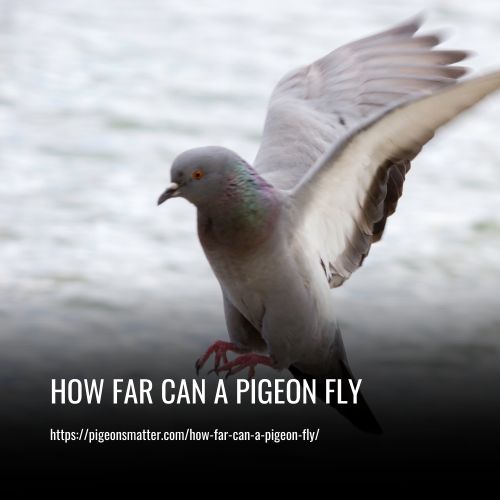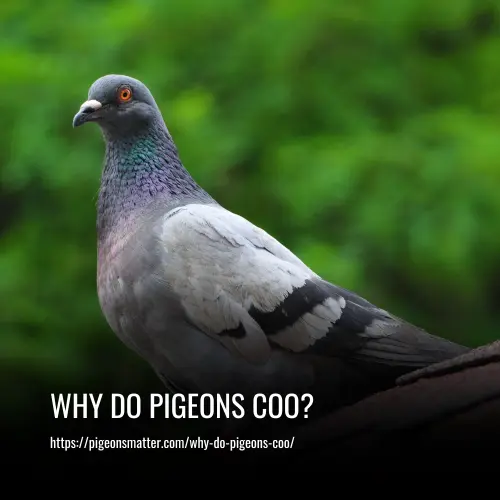Pigeons are truly remarkable birds with amazing flight capabilities. In terms of distance, they can fly up to an average speed of 77.6 mph and have even been recorded flying as fast as 92.5 mph. As for endurance, they can fly between 600 and 700 miles in a single day. One stunning instance of this is the longest recorded flight in the 19th century, which took 55 days between Africa and England and covered a whopping 7000 miles.
When it comes to homing pigeons, their ability to fly long distances without stopping for rest is truly astounding. Despite weighing only one pound, they can fly between 500 to 800 miles a day at speeds of more than 60 mph. It’s hard to believe that in ancient times, homing pigeons could only manage a mere 100 miles a day with their breast muscles!

How Long Can A Pigeon Fly Without Stopping?
Pigeons possess a remarkable flying ability, allowing them to cover long distances without pausing, thanks to their distinctive flying style. Their short glides during each wing flap allow them to conserve energy, allowing them to fly for a longer period without tiring out. This energy conservation is essential for long-distance flying, as pigeons can cover hundreds of miles in a single day.
Pigeons are also equipped with a great respiratory system that allows them to take in more oxygen during the flight compared to when they are resting. This increased oxygen intake helps them stay energized and fresh for a longer duration of time.
The circulatory system of pigeons is also an important factor in their ability to fly long distances without stopping. It efficiently transports oxygen to all parts of their body, ensuring their muscles have the energy needed to keep flying.
Weather and climate can also play a role in how long and far pigeons can fly without stopping. Pigeons can adjust their flight speed and altitude to account for weather conditions such as wind and temperature changes, helping them to conserve energy and fly more efficiently.
How Far Can A Pigeon Fly Without Stopping?
Pigeons are resilient birds that can cover astounding distances without taking a break. They can fly up to 1100 miles a day without experiencing any exhaustion. Their greatness in covering long distances is attributed to their exceptional ability to fly without getting tired.
Pigeons fly at an average speed of 50 miles per hour, which means they can cover a significant distance in a day. However, this speed may be affected by wind conditions, whereby they can fly faster if the wind is in their favor, and slower if it is against them.
Pigeons are long-distance racers that have incredible endurance rates. They can cover long distances in a single day without showing any signs of fatigue. Although weather and climate conditions can affect their flight distance, pigeons can still cover a remarkable distance. Wind conditions can also affect their speed while flying, and they can adjust their speed depending on the wind direction to ensure that they continue flying without tiring.
In summary, pigeons can fly up to 1100 miles a day without needing a break. Their ability to fly long distances is attributed to their exceptional resilience and adaptation. They can adapt to different wind conditions and adjust their speed accordingly. Although weather and climate can affect their overall flight distance, pigeons still demonstrate impressive long-distance flying capabilities.
How Do Pigeons Fly Such Long Distances Without Getting Tired?
Pigeons are known for their remarkable ability to fly long distances without experiencing exhaustion. Their physical characteristics such as a well-developed respiratory system and powerful wings, enable them to take in more oxygen and stay energized for a more extended period. This respiratory system works to transport oxygen to their body parts and tissues, ensuring their muscles remain oxygenated, and they can continue to keep flying for miles.
The combination of a good respiratory system and a powerful circulatory system makes it easy for pigeons to sustain flight for long periods. This system helps to transfer oxygen to their muscles and tissues, allowing them to continue flying without getting tired. Additionally, pigeons have muscular legs, which help them to maintain their balance while in flight, thus conserving energy that would have otherwise been used to keep their balance.
The History of Pigeon Racing – A Not-So-Ancient Sport
Pigeon racing traces its roots to the 19th century in Belgium. By 1881, the Belgians had organized regular competitions, giving rise to the sport of homing pigeon racing. Pigeon racing, however, was not practiced in ancient times, despite humans’ long-standing affinity with these birds across a variety of regions, including the Middle East, where they were considered pets and admired for their striking aesthetics.
As with any competitive sport, time and distance became crucial measures of the event’s success. In 1818, the first certified long-distance race took place in Belgium, gradually extending from shorter local races to longer ones that have become the norm. The sport became widely popular in Europe, and eventually, it crossed the Atlantic to North America in the 19th century.
Today, pigeon racing is a global phenomenon that has spread not only throughout Europe and North America, but also to Asia, with many enthusiasts in India, China, Taiwan, and the Philippines. Modern races are typically grueling endurance feats fraught with many natural hazards that pose serious challenges to the birds and their handlers.
1. The Greatest?
Determining the greatest long-distance feat accomplished by a pigeon is a challenge, as there is no unified global organization to verify such claims. Consequently, these feats are based only on unverifiable claims, rendering them occasionally false or true.
One such claim is that of a pigeon that flew from Arras, in France, to Saigon, in Vietnam, in 1931, covering a distance of 7,200 miles over 24 days. Such an achievement is truly exceptional, and feats such as these are a testament to the grueling endurance of these birds when they are facing dangerous conditions, such as birds of prey and pigeon poachers.
2. Old Days:
During the rise of the US railway system, homing pigeons were said to have surpassed even the swiftest locomotives. In one particular instance, a three-hour train ride was outdone by a pigeon in just over an hour. Clocking in at an average speed of 1,200 yards per minute, this avian athlete proved its unparalleled talent.
Endurance is a fundamental component of pigeon racing, and homing pigeons are capable of up to 13 hours of non-stop flight. While short-distance flyers have peaked at over 110 mph, long-distance races are much more demanding and pose various natural challenges. Despite these obstacles, the popularity of pigeon racing has only grown, with the sport becoming more widespread with each passing year.
How Long Does it Take a Pigeon to Fly 100 Miles?
When it comes to how long it takes a pigeon to fly 100 miles, there are some important factors to consider. Most notably, the speed at which the pigeon is flying will have a large impact on the amount of time it takes to cover the distance. Based on the average speed of 50 miles per hour, a pigeon would need approximately 2 hours to fly a distance of 100 miles.
However, other factors can come into play as well. One important consideration is the wind conditions that are present during the flight. If favorable winds are present, the pigeon may be able to fly faster than 50 mph, which could allow the bird to cover the distance in less time. On the other hand, if the wind conditions are not ideal, the pigeon may have to slow down, which would increase the amount of time it takes to fly the 100 miles.
Racing pigeons are prized for their stamina, agility, and energy storage, which can help them cover long distances without getting tired. With that said, sometimes even the most well-trained racing pigeons may need some extra time to fly 100 miles. On average, however, most healthy and well-conditioned pigeons should be able to cover this distance in around 2 hours.
How To Identify Long-Distance Racing Pigeons?
To identify long-distance racing pigeons, it’s important to pay attention to their unique wing markings. These birds have distinctive markings which usually consist of two bars or chevrons, situated on the outermost feathers of their wings. Combining these markings with their larger size compared to other types of pigeons, it’s easier to distinguish them.
Apart from wing markings and larger size, long-distance racing pigeons are visibly distinguishable by their muscular build and wider chests. This conformation grants them extra strength and endurance required to fly for longer durations covering longer distances as compared to other pigeon breeds. So, if you notice a pigeon exhibiting such a bulkier form, it’s more likely to be a long-distance racer.
How Many Hours Can a Pigeon Fly?
One question that often comes up when discussing pigeon flight is how long they can fly without taking a break. Typically, pigeons can soar through the skies for up to 12 hours before needing to rest. Their respiratory and circulatory systems are highly efficient, meaning they can efficiently use energy stores to remain in the air for extended periods.
One of the unique characteristics that allow pigeons to maintain such impressive flight durations is their capacity for energy storage. They can store large amounts of glycogen in their muscles and liver, which can be metabolized to provide energy for flying without the need for food or water while in flight.
Pigeons also have a fast flight speed, averaging around 60 miles per hour. However, this speed can vary according to weather conditions, as wind patterns affect the ease or difficulty of the flight path. If the wind is in their favor, pigeons can fly even faster, while an opposing wind will cause them to slow down somewhat. Even with such obstacles, pigeons are capable of covering vast distances in flight without tiring.
Can Pigeons Fly at Night?
Pigeons are primarily diurnal birds, meaning they are active only during the daytime. Due to their limited eyesight at night, they cannot fly in the dark. However, there are certain circumstances where they may take flight at night to ensure their safety, such as when there is a predator near their nesting site. In such cases, pigeons may fly short distances and break their flight path into several smaller steps while keeping a low profile to avoid attracting attention.
Although they prefer to roost in various locations such as buildings, bridges, trees, and cliffs, pigeons may also use man-made structures such as pigeon lofts to rest at night. While they have certain limitations at night, such as poor eyesight, they have developed other mechanisms to protect themselves from predators and to withstand the cold.
How high can a pigeon fly in the sky?
Pigeons are remarkable flight creatures capable of flying at a maximum height of around 6000 feet in the sky. During migration, they take advantage of flying at this altitude to gain a panoramic view of their surroundings and quickly spot potential predators. Not only this but flying at high altitudes also allows them to conserve energy as they can take advantage of the wind currents.
Moreover, flying at a high altitude also offers several benefits to these agile birds. Higher altitudes bring lower temperatures, and pigeons can thus fly higher to gain strategic relief from hot weather. On the contrary, low-flying birds cannot benefit from the same level of thermal regulation and often suffer from heat-related hazards.
However, flying at a high altitude also poses potential dangers to these birds. It exposes them to cold weather, and if not well-maintained, their digestive system can also get affected during long-duration flights. Nonetheless, pigeons have evolved the necessary mechanisms to remain resilient and survive at high altitudes.
FAQs
Pigeons have strong wings and can fly at high altitudes. They conserve energy by using wind currents. They can fly non-stop for up to 1100 miles. They have a good sense of direction and can navigate unfamiliar areas easily.
During the flight, pigeons have unique behaviors that help them adapt. They fly in flocks to protect their young and minimize predation risk. Pigeons regulate their body temperature by puffing or flapping their wings. In distress, they can perform acrobatic maneuvers to evade predators.
The longest distance flown by a pigeon, according to the American Racing Pigeon Union, stands at a staggering 7,200 miles. The bird, a specially trained pigeon, flew from South Africa to the United Kingdom, covering the distance in approximately 55 days. This feat is a testament to the exceptional flight capabilities and homing instincts of these remarkable birds.
Several pigeon species are used in pigeon racing, with the most common being Homing Pigeon, also known as Columba livia. Other popular species include Racing Homer, German Beauty Homer, and the Dutch Tumbler. These species have all been bred selectively over the years for their speed, athleticism, and endurance, making them ideal for competitive pigeon racing.
The American Racing Pigeon Union (ARPU) was established in 1910, promoting the sport of pigeon racing. The union facilitates networking, competitive racing, and knowledge exchange for pigeon fanciers. They also keep a pedigree database, host national races, and provide support services and resources to members. The ARPU has been instrumental in the growth and development of pigeon racing.
Conclusion:
This article has highlighted the exceptional flight capabilities of pigeons, including their ability to fly at high altitudes and cover long distances of up to 1100 miles non-stop. We have also discussed the unique behaviors they exhibit during flight, such as their flocking behavior and homing instincts. Furthermore, we learned about the longest distance ever flown by a pigeon, which stands at a staggering 7,200 miles.
This article can be helpful for anyone interested in pigeon racing, as it provides valuable information on the different pigeon species commonly used in the sport, as well as the role of organizations such as the American Racing Pigeon Union.


